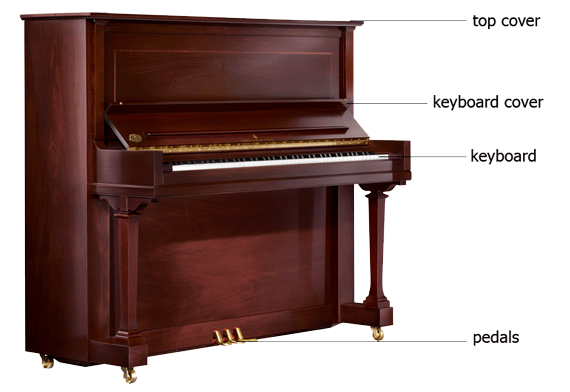» Organology » Piano

Family
keyboard instruments
(also categorized as string and percussion instruments)
Description
The piano has occupied a central place in professional and domestic music-making since the third quarter of the 18th century. In addition to the great capacities inherent in the keyboard itself – the ability to sound simultaneously at least as many notes as one has fingers and therefore to be able to produce an approximation of any work in the entire literature of Western music – the piano’s capability of playing notes at widely varying degrees of loudness in response to changes in the force with which the keys are struck, permitting crescendos and decrescendos and a natural dynamic shaping of a musical phrase, gave the instrument an enormous advantage over its predecessors, the clavichord and the harpsichord. The capabilities later acquired of sustaining notes at will after the fingers had left the keys (by means of pedals) and of playing far more loudly than was possible on the harpsichord made this advantage even greater.
The instrument’s modern name is a shortened form the term ‘pianaforte’ which indicates the ability of playing at widely varying degrees of loudness.
Modern pianos have two basic configurations : the grand piano and the upright piano. In grand pianos, the frame and strings are horizontal, with the strings extending away from the keyboard. The action lies beneath the strings, and uses gravity as its means of return to a state of rest. Upright pianos, also called vertical pianos, are more compact because the frame and strings are vertical. The hammers move horizontally, and return to their resting position via springs. Piano has the second widest playing range and the most various timbre after organ. The piano playing range is a little more than seven octaves. Piano features made it feasible of being an indispensable member of solos, accompaniments and chamber orchestras.
Composers
The story of the great classical composers of piano music actually begins before the invention of the piano itself. We will start ours with Johann Sebastian Bach. Other composers who wrote for the piano are Scarlatti, Clement, Mozart, Beethoven, Czerny, Schubert, Mendelson, Schumann, Chopin and Liszt.
Players
players who changed the history of piano are Beethoven, Chopin, Liszt, Rubinstein, Rachmaninoff, Josef Hofmann, Vladimir Horowitz and Alfred Brendel.
Piano parts

Audio sample
Title: piano concert No.1 Op.11
Artist: Chopin
Title: piano sonata No. 14 in C-sharp minor, (moonlight sonata)
Artist: Beethoven

